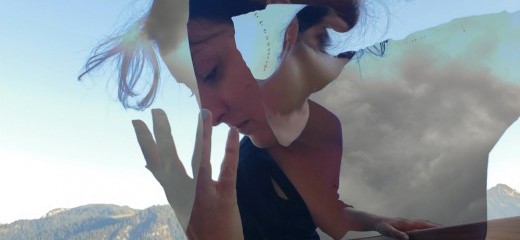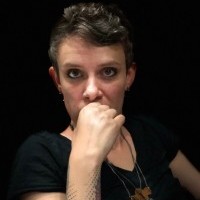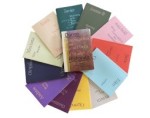
Improvisation in the Virtual Frame
by Emilee Lord
January and February, synonymous with freezing temperatures and short days, are months that require resolve. While I would normally have spent as much of that time as possible under a blanket with a book, I instead embarked on a journey to reacquaint myself with my improvisational practice, while beginning to learn about dance for camera. Composing While Dancing (titled after a book by Melinda Buckwalter) was a seven class series taught by dance and teaching artist Zornitsa Stoyanova, a fellow writer at thINKingDANCE. The classes covered dance improvisation and an introduction to technical aspects of the camera frame. Stoyanova and I attended Bennington College together and it was a pleasure to sit with before and after the series to catch up and discuss the course material on Zoom. What follows are excerpts from our conversations.
Emilee Lord: Let’s talk a little about your experience and working methodology for improvisational practice. How would you encapsulate this?
Zornitsa Stoyanova: I practice improvisation specifically for performance, and that’s what I teach. I don’t focus on improv as a way to choreograph. And I started using the camera as a substitute for live because that’s what was available. For me it was important to have a sense of practicing performance. It evolved from there.
EL: You say film has become a serious part of your work, and I’m interested in how improvisational practice differs when made for camera vs live. What interests you about that?
ZS: I feel perfectly fine just walking into a studio or a theater without anything prepared and bringing forth something, using all these techniques that many of us know to illuminate the room. With video it’s forcing you to be more choreographed. You no longer have a room, you have a frame, and that frame is much smaller. Not to say that you are not in a room and it’s not available to you, it’s to say that now you have more power to frame the tension of your audience… And you have to set up. You have to make decisions beforehand and you have more tools to play with on top of all your choreographic tools.
EL: What specifically brought you to create this series?
ZS: Two things, one is loneliness, like everybody is dealing with… the need to be with people who care about the things I care about. The second comes from a place where I am not seeing what I want to be seeing. Can we please imagine different ways of using this amazing virtual space…so let’s gather and really use the space creatively. Live Zoom performance right now just looks like documentation, to me, and I don’t see anything else. And creatively, artistically, I’d like to change that. I’d like too, as an audience member, to see innovation in the way we use this technology. No it’s not the same. But what is it? What can it be? This is something really special where we can glimpse into each other’s time and space.
EL: Yeah I love that. It has the potential to be more intimate because of these glimpses. As a student in your series it was strange to have people watch me explore movement in my own home. We were sharing with each other from our own spaces.
ZS: My hope is that folks felt less intimidated by technology and more excited about different ways they can use it creatively. I wanted people to feel seen. So I wanted to structure enough time for moving and reflection.
EL: You introduced the course with a first session dedicated to understanding technological choices and the frame of the camera. The introduction to the frame was really crucial in the beginning of this workshop; we had to interact with each other in the frame we were talking about artistically. The rest was giving us a collection of tools, really your whole toolbox. I wasn’t able to join the last couple of sessions so, using your recordings, instead of following the prompts, I watched how people were using their screens, and observed where I thought it worked and didn’t. I thought it was fascinating to get to observe the structure and think about what dance and movement learning can be on this platform.
ZS: My goal is always to give as many tools as possible -- and with Zoom, yeah, I wanted to constantly remind people of their new stage. It was really interesting to see everybody try to just shape these ideas I have about improv in a way that is translatable.
EL: What were some challenging parts?
ZS: Everyone is in silent mode and I’m speaking and playing music and I don’t know how to read the room. I’m saying feel free to make noise but are people making noise? I teach by doing, so I would be doing these things and talk about them but I couldn’t feel or observe responses. I was also surprised at how quiet people were when I tried to ask for comments and questions after exercises. But there was a different group each time. That was so incredible! Almost all of these people I have never met! And I got a lot out of it.
EL: I also was so surprised at how quiet the group was in feedback moments. So did you get the same kind of energy exchange or feedback that teaching in person can generate?
ZS: No, but I was surprised by how much I did get; how much I was invigorated and excited. And how important it was to be in a virtual room with people who care about things I care about. In that way it was deeply satisfying. It felt like I was working on my work by teaching.
EL: It did feel like you made the process of improv for performance accessible, not intimidating.
ZS: “Get what you need.” Deborah Hay said. I use that all the time. But also lately, and this is blowing my mind, she would say, “What if where you are is what you need?” She took the worry out of needing to make decisions in movement in time. This is part of the lineage. This is what I’m sharing. I want to see improvisation get handled in a performative way.
EL: Improvisation is a tool for generating choreography, but that’s not what you’re talking about?
ZS: No not even a little bit. I’m starting to learn that my knowledge is unique and valuable. And a reason to keep teaching is to find like-minded people to dance with. I really want to teach this for an ensemble. I miss that. You know what it was like for us to dance with Susan Sgorbati at Bennington, and I’m realizing the longer I go through this world how incredibly rare that is. And that’s what I really deeply care about. I’ve been thinking a lot about how to make more of it happen; to create a community for performative improvisation.
EL: I love that. I am 100% behind that happening. Count me in.
Composing While Dancing, taught via Zoom by Zornitsa Stoyanova, Jan. 13 - Feb. 19.
By Emilee Lord
March 19, 2021










